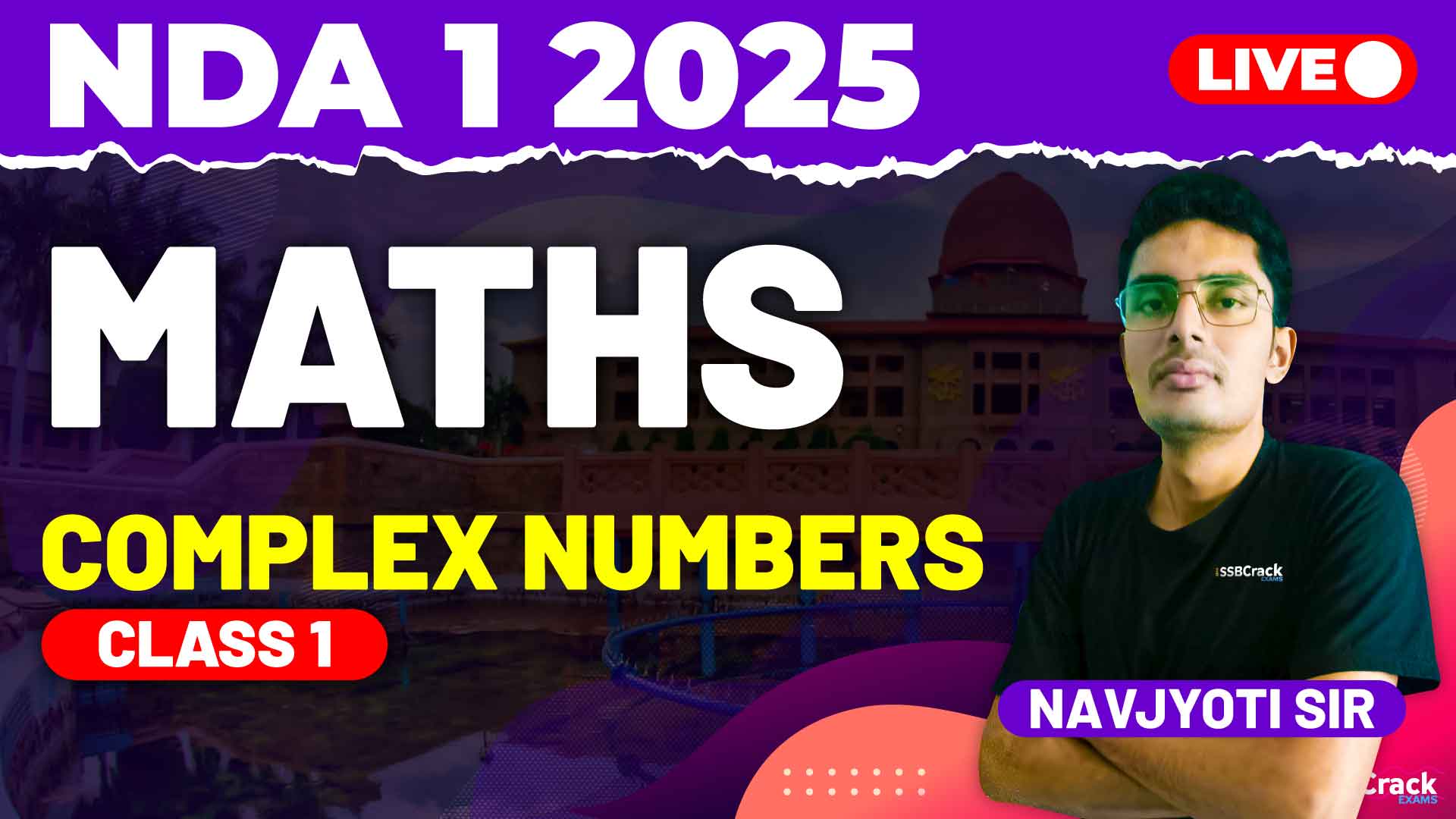In a recent class for the National Defence Academy and Naval Academy (NDA-NA) Exam – Paper I (Maths), the topic of Complex Numbers was covered in detail. The session focused on key sub-topics such as Imaginary Numbers, Complex Numbers, powers of iota (i), operations on complex numbers, and important concepts like modulus and conjugate, along with their properties.
This blog will recap the core concepts discussed in the class and outline effective strategies to help you prepare for this topic. The goal is to provide a simple yet comprehensive guide to approaching complex numbers, a crucial topic in the NDA-NA syllabus.
Key Concepts Discussed in the Class
1. Imaginary Numbers
The class began by revisiting the concept of imaginary numbers, which form the foundation of complex numbers. An imaginary number is typically expressed in terms of iota (i), the unit imaginary number. The key idea discussed was that while real numbers are sufficient for most calculations, imaginary numbers are essential when dealing with the square roots of negative numbers.
2. Complex Numbers
Following the introduction to imaginary numbers, the class delved into complex numbers, which are numbers of the form “a + bi”, where a is the real part and bi is the imaginary part. This combination of real and imaginary parts allows complex numbers to represent a broader range of quantities and solve problems that are not solvable using real numbers alone.
The importance of understanding how complex numbers behave in algebraic operations such as addition, subtraction, multiplication, and division was emphasized. These operations on complex numbers were explained in the class with examples to highlight the unique behavior of these numbers.
3. Powers of iota (i)
A significant portion of the class was dedicated to understanding the powers of iota (i). Since iota represents the square root of -1, powers of i follow a cyclic pattern. The class discussed how this cyclic nature simplifies complex expressions involving higher powers of iota.
Understanding these powers and how they simplify calculations in problems involving complex numbers is key, especially in MCQs where time-saving shortcuts can be critical.
4. Operations on Complex Numbers
The session also covered basic operations involving complex numbers:
- Addition and subtraction of complex numbers involve separately adding or subtracting the real and imaginary parts.
- Multiplication involves expanding the product of two complex numbers and simplifying using the known properties of iota.
- Division was explained by multiplying both the numerator and the denominator by the conjugate of the denominator to simplify the expression.
These operations were essential for solving various problems during the class, and practice is necessary to master them.
5. Modulus and Conjugate
Another critical topic discussed was the concept of the modulus and conjugate of a complex number. The modulus of a complex number measures its “size” or “distance” from the origin in the complex plane, which is useful in geometry-based problems.
The conjugate of a complex number involves changing the sign of the imaginary part. It is particularly useful when simplifying expressions, especially in division. The relationship between a complex number and its conjugate, and how they are used to derive useful properties, was thoroughly discussed in the class.
6. Properties of Modulus and Conjugate
The class wrapped up with a discussion of important properties of the modulus and conjugate. These properties help in simplifying complex expressions and solving problems more efficiently. Understanding these properties allows for quicker calculations and better conceptual clarity when tackling questions involving complex numbers.
Strategies for Preparing Complex Numbers for the NDA-NA Exam
To ensure success in the topic of complex numbers for the NDA-NA exam, it’s essential to adopt a structured approach. Below are some strategies that were highlighted during the class, along with additional preparation tips:
1. Master the Basics First
Before attempting more complex problems, make sure to have a strong grasp of the basics, such as the definition of imaginary and complex numbers, powers of iota, and simple operations. Memorizing these fundamentals will make it easier to handle more advanced concepts.
- Practice identifying the real and imaginary parts of complex numbers in different forms.
- Familiarize yourself with the cyclic pattern of the powers of i to save time during calculations.
2. Practice Operations on Complex Numbers
Operations on complex numbers may seem simple, but they can be tricky when applied in problem-solving. Regular practice with addition, subtraction, multiplication, and division is essential.
- Work on basic operations regularly until they become second nature.
- Practice questions involving division using the conjugate, as this is a common area where students struggle.
3. Understand Modulus and Conjugate
The modulus and conjugate are essential tools for solving problems involving complex numbers. Focus on:
- Understanding how the modulus gives you a geometric interpretation of complex numbers and helps in finding distances.
- Knowing when and how to apply the conjugate in simplification.
- Practice using modulus and conjugate in both algebraic and geometric problems.
- Memorize the key properties of modulus and conjugate as they frequently appear in MCQs.
4. Solve Previous Years’ MCQs
As emphasized during the class, solving previous years’ questions is one of the most effective ways to prepare for this topic. It not only helps you understand the type of questions that may appear in the exam but also gives you a better idea of which concepts are most frequently tested.
- Start by solving topic-specific MCQs on complex numbers.
- Gradually time yourself while solving these questions to improve your speed and accuracy.
5. Focus on Conceptual Understanding
Many questions in the NDA-NA exam require a deep understanding of the concepts rather than rote memorization. Ensure that you understand why a particular approach works instead of merely memorizing steps. This will help you tackle unfamiliar problems with confidence.
- Make sure you can explain complex number operations, modulus, and conjugate to someone else; teaching is a great way to solidify your knowledge.
- Regularly revisit the properties of complex numbers and try applying them in different contexts.
6. Take Mock Tests
Mock tests are a great way to simulate the exam environment. They help you identify your strengths and weaknesses while improving your time management skills. After each test, analyze your performance, review your mistakes, and work on the areas where you need improvement.
- Take a mock test at least once a week as the exam approaches.
- Review complex number problems in the tests to ensure you are applying the correct strategies.
Conclusion
The recent class on Complex Numbers for the NDA-NA exam provided students with a thorough understanding of key concepts, from imaginary and complex numbers to the powers of iota, and operations such as addition, multiplication, modulus, and conjugate. The focus on solving previous years’ MCQs allowed students to see how these concepts are applied in real exam scenarios.
For exam success, mastering the basics of complex numbers, practicing operations regularly, understanding the modulus and conjugate, and solving MCQs from past exams are crucial strategies. By following these preparation strategies and incorporating them into your study plan, you can confidently approach the complex numbers section of the NDA-NA exam.
With consistent practice and a solid understanding of the concepts, complex numbers can become a scoring area in the NDA-NA Maths exam. Stay focused, practice regularly, and you’ll be well-prepared to tackle this topic with ease.



















